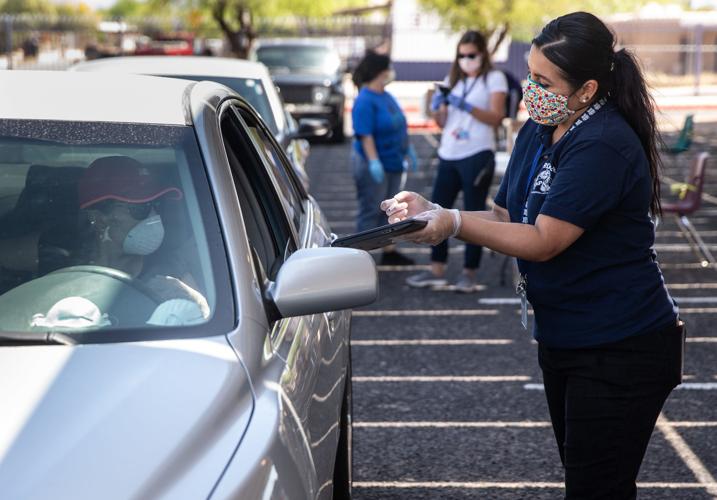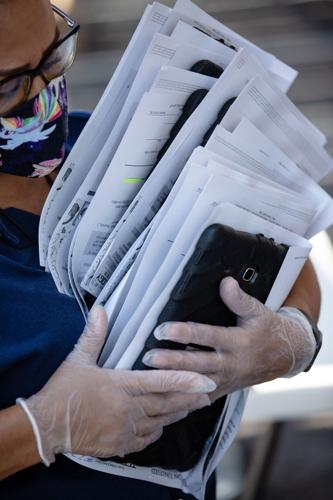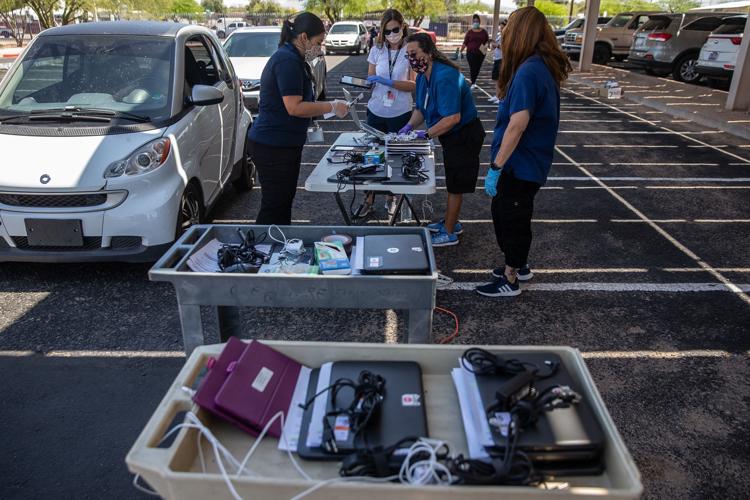TucsonŌĆÖs public schools have been forced to make a huge effort to narrow the digital divide among students since campuses across Arizona were ordered shut during the pandemic ŌĆö and are doing so with nearly no help from the state.
The Tucson Unified School District, the largest in the city, began the closures with 10% to 15% of its families lacking home internet service and far more lacking online devices like desktop computers and laptops. By next week, TUSD will have distributed over 19,000 devices, which includes laptops, Chromebooks and tablets, to students who lacked access to online learning.
The digital divide in TUSD was pronounced, said Blaine Young, the districtŌĆÖs chief technology officer. The district had been working on addressing that disparity in the classroom, earning grants that provided Chromebooks with mobile hot spots to some grades at a few underprivileged schools. But the pandemic forced a quick response from TUSD to address digital inequity in the home.
People are also reading…
ŌĆ£WeŌĆÖre built to serve brick-and-mortar schools,ŌĆØ Young said. ŌĆ£WeŌĆÖve had to adjust to serve, instead of 86 schools, 27,000 households.ŌĆØ
The district invested $3.5 million in Chromebooks, emptied schools of laptops and tablets collecting dust in vacant classrooms, and walked many families through accessing free and affordable internet, which companies like Cox and Comcast are offering during school closures.
TUSD bought 12,000 Chromebooks, of which it anticipates distributing half.
It is also distributing about 10,200 laptops from its existing inventory for older students and 3,000 tablets for kindergartners and first-graders.
To afford the Chromebooks, TUSD put some plans it had for next year on hold, said Superintendent Gabriel Trujillo.
Those plans included school parking lot improvements; adding more librarians in middle schools and music teachers in elementary schools; refurbishing music, band and sports equipment; and more.
The district also added five employees to its information technology service team. Still, the bigger 15-member team is not enough to serve 27,000 households in TUSD, which has required teachers and principals to help get families online.
Only a couple of Amy SingletaryŌĆÖs 26 kindergartners had both internet service and devices. The Wright Elementary kindergarten teacher, who doubles as the schoolŌĆÖs IT czar, worked 14-hour days for two weeks laying the groundwork for staff and families to make the transition to online learning.
Wright is a Title I school, meaning the majority of students are low-income. Principal Deanna Campos estimates about 20% of students had access to online learning at home.
And it wasnŌĆÖt just access the families lacked, but basic knowledge on how to navigate the platforms that had suddenly become a critical part of their childrenŌĆÖs daily lives.
Getting online isnŌĆÖt just important for academics but to keep kids connected with their school community and daily routines, Singletary said.
ŌĆ£So they donŌĆÖt feel so isolated. They feel like theyŌĆÖre still having that connection, not only with their teacher but with their friends. We still have a lot of the same familiar expectations that we would have in the classroom, but weŌĆÖre doing them online,ŌĆØ she said.
After distributing devices and information about low-cost internet, nearly her entire class has been able to get online, Singletary said. Between posting YouTube videos for her class and being introduced, virtually, to her young studentsŌĆÖ pets, she fields calls with families who need help figuring out the online learning platforms.
A handful of Wright staff members spent Wednesday at the school, wearing protective masks and handing out devices to excited families. Teachers called the parents, reminding them to come pick up a computer.
And for the families who lack transportation, the districtŌĆÖs Dropout Prevention Team plans to deliver devices to possibly hundreds of homes across TUSD.
ŌĆ£If you want access, you can get it,ŌĆØ Campos, WrightŌĆÖs principal, said. ŌĆ£IŌĆÖm actually really proud of what TUSD has done. TheyŌĆÖve gone beyond what is expected, considering the circumstances.ŌĆØ
The Sunnyside Unified School District, TucsonŌĆÖs second-largest and one of the poorest in the area, was better prepared for online learning than some other districts here. ThatŌĆÖs because Sunnyside began investing in laptops in 2011, when district voters approved a bond that provided $27 million for every fourth- through 12th-grade student to get a personal laptop.
Since the closure of schools, the district began using school buses as hot spots, parking at various schools so students could get online from outside the school and download assignments.
For its lower grades, Sunnyside is distributing about 1,100 laptops that were coming to the end of their service life but are still in working order, said Chief Information Officer Javier Baca.
Irene Gastelum said her first-grader, Jace, was very excited to get a laptop just for himself. Gastelum was also excited. The social worker, working at home, was juggling two laptops between herself and her three children.
With his own computer, Jace has been able to settle into a stable routine, Gastelum said. He is able to check his own assignments, watch YouTube videos his teacher posts and regularly interacts with his teacher and classmates.
ŌĆ£With this remote learning, I think he really misses that engagement,ŌĆØ she said. ŌĆ£The laptop has provided that opportunity to still communicate with teachers and classmates, which he really enjoys.ŌĆØ
Like Sunnyside, the Marana Unified School District was able to get mobile devices for students through a voter-approved bond several years ago.
The Vail School District already had a one-to-one program for its older students. And many other districts, including Sahuarita, Tanque Verde and Flowing Wells, have lent Chromebooks to families who indicated they needed one, although some districts had to prioritize them for higher grades due to the demand.
Despite all these efforts, a digital gap remains, which most districts have yet to quantify.
The state began a mobile hot spot donation drive, delivering 200 hot spots to students in rural and remote areas and asking partners in the nonprofit and private sectors to step up as well. Arizona schools chief Kathy Hoffman said the first round was just a ŌĆ£drop in the bucket in terms of need.
ŌĆ£The need for hot spots across the state is incredibly immense, and we have a long way to go in terms of ensuring that kids have access to the internet and to devices,ŌĆØ she said.
Photos for April 23: Tucson gets by during Coronavirus Pandemic
Tucson, coronavirus

Erika Munoz, owner of Seis Kitchen, hands over a bag of meals to Michael Gallagher Carondelet, a registered nurse at St. Joseph's Hospital, to distribute to other nurses and hospital workers, on April 23, 2020. The donation was made in conjunction with A+C (Athletes/Artists+Causes) Foundation's ŌĆ£Project Frontline.ŌĆØ In two deliveries, 400 meals (200 poc chuck chicken and 200 puerco verde burritos) will be given to medical personnel at Carondelet St. JosephŌĆÖs Hospital. The particular donation was made possible by the Houston Astros' Pitching Coach Brent Strom, who lives in Tucson.
Tucson, coronavirus

Hospital workers wheel in carts full of catered meals donated by Seis Kitchen to Carondelet St. Joseph's Hospital, on April 23, 2020. The donation was made in conjunction with A+C (Athletes/Artists+Causes) Foundation's ŌĆ£Project Frontline.ŌĆØ In two deliveries, 400 meals (200 poc chuck chicken and 200 puerco verde burritos) will be given to medical personnel at Carondelet St. JosephŌĆÖs Hospital. The particular donation was made possible by the Houston Astros' Pitching Coach Brent Strom, who lives in Tucson.
Tucson, coronavirus

Kristi Hall, a sixth grade teacher at Desert Sky Middle School, participates in planning a lesson with a fellow teacher on Zoom, at her home on April 17, 2020. Schools in the Vail School District are supposed to open in July due to their year-round school calendar. Plans are being made for the possibility of students returning to the physical classroom.
Tucson, coronavirus

Bry Kelley, a warehouse assistant, places a pallet filled with food down next to other items donated to the Community Food Bank of Southern ├█╠ęė░Ž±AV on on April 21, 2020. Forty-one thousand pounds of flour, pasta and canned goods were donated by The Church of Jesus Christ of Latter-day Saints. The donation is part of an ongoing global effort by the church to address immediate needs of people and orgainzations due to the coronavirus disease (COVID-19) pandemic.
Tucson, coronavirus

A pallet of food is placed down next to other items donated to the Community Food Bank of Southern ├█╠ęė░Ž±AV on on April 21, 2020. Forty-one thousand pounds of flour, pasta and canned goods were donated by The Church of Jesus Christ of Latter-day Saints. The donation is part of an ongoing global effort by the church to address immediate needs of people and orgainzations due to the coronavirus disease (COVID-19) pandemic.
Tucson, coronavirus

Christian Bergman, 4th year University of Arizona medical student, takes the temperature of a patient outside the Z Mansion, 288 N. Church Ave., in Tucson, Ariz., on April 19, 2020. Medical students from the University of Arizona and other universities volunteer to help the homeless population with the growing concerns of Coronavirus Disease (COVID-19) within the homeless population. ŌĆ£This is a vulnerable population in our community; they canŌĆÖt defend themselves in a society already running short on supplies and resources,ŌĆØ said Bergman. Medical students and medical personal help by giving out food, drinks with electrolytes and masks to the homeless. Those who are sick, medically impaired or have been exposed to those with COVID-19 are isolated outdoors in tents on the property. As of Sunday April 19, there were 13 individuals whom are isolated in tents.
Tucson, coronavirus

Lekha Chesnick, 1st year medical student at Burrell College of Osteopathic Medicine, talks with a homeless man (whom choose to not give his name) outside of the Z Mansion, 288 N. Church Ave., in Tucson, Ariz., on April 19, 2020. Medical students from the University of Arizona and other universities volunteer to help the homeless population with the growing concerns of Coronavirus Disease (COVID-19) within the homeless population. Medical students and medical personal help by giving out food, drinks with electrolytes and masks to the homeless. Those who are sick, medically impaired or have been exposed to those with COVID-19 are isolated outdoors in tents on the property. As of Sunday April 19, there were 13 individuals whom are isolated in tents.
Tucson, coronavirus

Christian Bergman, 4th year University of Arizona medical student, checks on a patient outside the Z Mansion, 288 N. Church Ave., in Tucson, Ariz., on April 19, 2020. Medical students from the University of Arizona and other universities volunteer to help the homeless population with the growing concerns of Coronavirus Disease (COVID-19) within the homeless population. ŌĆ£This is a vulnerable population in our community; they canŌĆÖt defend themselves in a society already running short on supplies and resources,ŌĆØ said Bergman. Medical students and medical personal help by giving out food, drinks with electrolytes and masks to the homeless. Those who are sick, medically impaired or have been exposed to those with COVID-19 are isolated outdoors in tents on the property. As of Sunday April 19, there were 13 individuals whom are isolated in tents.
Tucson, coronavirus

Elliott Dumont, owner of Roadrunner Bicycles, 6177 E. Broadway Blvd., works on a customer's bike on April 22, 2020. The coronavirus disease (COVID-19) has not slowed down bike shops. With many people at home, they are bringing bicycles for repairs and buying new ones for exercise. Dumont says he's booked out till the first week of May for tuneups on bikes.
Tucson, coronavirus

Elliot DuMont, owner of Roadrunner Bicycles, 6177 E. Broadway Blvd., far left, helps Ethan Sasz, far right, and his son, Evan, 10, with a mountain bike purchase on April 22, 2020. The coronavirus disease (COVID-19) has not slowed down bike shops. With many people at home, they are bringing bicycles for repairs and buying new ones for exercise. Dumont says he's booked out till the first week of May for tuneups on bikes.
Tucson, coronavirus

Marcella Montoya waits in her vehicle as general manger David Kessler brings out her order, as Bear Canyon Pizza serving their customers despite COVID-19 restrictions, April 22, 2020, Tucson, Ariz.
Tucson, coronavirus

Kitchen manger Koa Hoffmann tosses dough while working up a crust for a call-in order as he and few others keep cooking at Bear Canyon Pizza despite COVID-19 restrictions, April 22, 2020, Tucson, Ariz.
Tucson, coronavirus

Alvaro Enciso, a local artist, works in one of his studios at his home on April 9, 2020. Every Tuesday Enciso travels into the Sonoran desert to post crosses where migrants have died after crossing illegally over the U.S./Mexico border as part of a project he's titled Donde Mueren Los Suenos / Where Dreams Die. With the outbreak of the coronavirus disease his six year project is on hold and instead he works on other artwork at home.
Tucson, coronavirus

Dolly Spalding works on a pen and ink drawing in her apartment at the Redondo Tower Apartments on April 7, 2020. During her quarantine, Spalding has been creating drawings of all the Greek goddesses. She is collaborating with Emlyn Boyle, an artist from Ireland, and plans to publish a book with Boyle's writings.




















